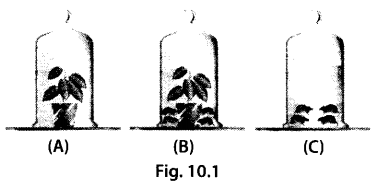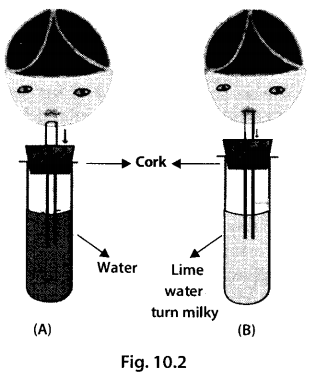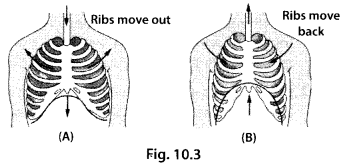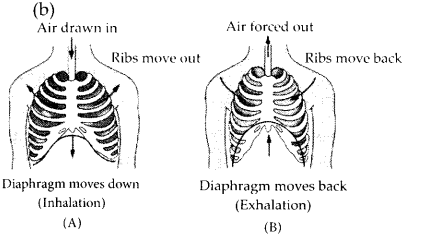Table of Contents
NCERT Exemplar Solutions Class 7 Science Chapter 10 Respiration in Organisms is crucial for the students of the 7th standard. The solutions are provided here to help students understand the Chapter in an interesting way. These NCERT Exemplar Solutions for Class 7 Science Chapter 10 are created by subject experts according to the latest CBSE syllabus. Students must practice the solutions regularly to prepare effectively for their examinations. NCERT Exemplar Solutions for Class 7 Science Chapter 10 are outlined in such a way that every student can comprehend the concepts easily. These solutions comprise a wide range of topics.
Important topics covered in NCERT Exemplar Solutions for Class 7 Science Chapter 10 Respiration in Organisms
- Why do we respire?
- Breathing
- How do we breathe?
- What do we breathe out?
- Breathing in other animals
- Breathing underwater
- Do plants also respire?
NCERT Exemplar Solutions Class 7 Science Solutions Chapter 10 Respiration in Organisms
NCERT Exemplar Class 7 Science Solutions Chapter 10 Respiration in Organisms
Multiple Choice Question on Chapter 10 Respiration in Organisms
Question 1: Sometimes when we do heavy exercise, anaerobic respiration takes place in our muscle cells. What is produced during this process?
- Alcohol and lactic acid
- Alcohol and CO2
- Lactic acid and CO2
- Lactic acid only
Solution:
(d) When we do heavy exercise our body does not get enough oxygen to produce the required energy. To get additional energy, anaerobic respiration occurs within our muscle cells. In this process, there occurs partial breakdown of glucose to produce lactic acid. The accumulation of lactic acid in the body causes muscular cramps.
Question 2: Yeast is used in wine and beer industries because it respires
- aerobically producing oxygen
- aerobically producing alcohol
- anaerobically producing alcohol
- anaerobically producing CO2.
Solution:
(c) Yeast (fungi) respires anaerobically and yields ethyl alcohol and carbon dioxide. Due to the production of ethyl alcohol, yeasts are used in brewing industry. This process of anaerobic respiration in yeasts is called as fermentation.
Question 3: During the process of exhalation, the ribs move
- down and inwards
- up and inwards
- down and outwards
- up and outwards.
Solution:
(a) During exhalation, the diaphragm moves up and ribs move downwards and inwards, decreasing the space in the chest cavity, this increases the air pressure inside the lungs and forces the air out of the lungs.
Question 4: Breathing is a process that
- provides 02 to the body
- breaks down food to release energy
- helps the body to get rid of CO2
- produces water in the cells.
Which of the following gives the correct combination of functions of breathing?
- (i)and(ii)
- (ii) and (iii)
- (i) and (iii)
- (ii) and (iv)
Solution:
(c) Breathing means taking in air rich in oxygen and giving out air rich in carbon dioxide with the help of respiratory organs. The taking in of oxygen-rich air into the body is called inhalation and giving out of carbon dioxide – rich air is known as exhalation.
Question 5: Fish breathe with the help of gills which are richly supplied with blood vessels. The gills help the fish to
- take in oxygen from air
- take in oxygen dissolved in water
- absorb nutrients present in water
- release waste substances in water.
Solution:
(b) Fish use gills for exchange of gases. Gills are made up of a large number of filaments, richly supplied with thin blood vessels called capillaries. As water enters through the mouth it flows over the gills. The blood in the capillaries absorbs oxygen dissolved in water, and gives out carbon dioxide into the water.
Question 6: Earthworms and frogs breathe through their skin because of which the skin of both the organisms is
- moist and rough
- dry and rough
- dry and slimy
- moist and slimy.
Solution:
(d) The skin of the earthworm and the frog feels moist and slimy on touching. It is because in earthworms and frogs, exchange of gases takes place by diffusion through the moist body surface.
Very Short Answer Type Questions
Question 7: Mark the following statements as True or False. Correct the false statements.
- Oxygen breaks down glucose outside the cells of organisms.
- Frogs can breathe through their skin as well as lungs.
- Insects have spiracles on the lower surface of the body.
- Exhaled air has more percentage of CO2 than inhaled air.
Solution:
(a) False. Oxygen breaks down glucose inside the cells of organisms.
(b) True
(c) False. Insects have spiracles on the sides of the body.
(d) True
Question 8: Fill in the blanks with suitable words.
- The roots of a plant take up oxygen from the ____ trapped between the particles.
- Diaphragm forms the ____ of the chest cavity.
- Exchange of gases in the leaves takes place with the help of ____.
- Cockroaches breathe with the help of air tubes called ____.
Solution:
(a) air, soil
(b) floor
(c) stomata
(d) tracheae
Short Answer Type Questions
Question 9: Pick the odd-one-out from each of the groups given below on the basis of respiratory organs. Give reason for your answer.
- Cockroach, grasshopper, snail, ant
- Lizard, cow, earthworm, snake
- Crocodile, whale, dolphin, fish
- Snake, tadpole, crow, goat
Solution:
(a) Snail is the odd one out. It is because cockroach, grasshopper and ant are all insects, which respire by means of tracheae, whereas most snails respire though gills.
(b) Earthworm is the odd one out because it respires through the skin by the process of diffusion, whereas lizard, cow and snake respire through lungs.
(c) Fish is the odd one out because fish respire through gills, whereas crocodile, whale and dolphin respire through lungs.
(d) Tadpole is the odd one out because it respires through gills, whereas snake, crow and goat respire through lungs.
Question 10: Which gas present in air is essential for aerobic respiration? What is the role of oxygen during respiration?
Solution:
Oxygen present in air is essential for aerobic respiration.
With the help of oxygen organic food is completely oxidised into carbon dioxide and water to release energy.
Glucose + Oxygen → Carbon dioxide + Water+ Energy
Question 11: On an average, an adult human being at rest breathes 15-18 times per minute. The breathing rate, however, may differ under different conditions. Arrange the following activities given in the box in order of increasing breathing rates and give reason for your answer.
[ Sleeping, Cycling, Brisk walk. Watching T.V. ]
Solution:
Sleeping < Watching T.V. < Brisk walk < Cycling
Breathing rate changes according to the requirement of oxygen by the body. It slows down when a person is taking complete rest. Whenever a person does any activity, the breathing rate becomes faster. It further increases with strenuous work to provide more oxygen to the cells to get more energy.
Question 12: On a very cold morning, Boojho and Paheli were talking with each other as they walked down to their school. They observed that the air coming out of their mouth looked like smoke. They were amused and wondered how it happened. Help them find the answer.
Solution:
On a cold day, the warm and moist air exhaled by us condenses into mist when it comes in contact with the cold air of the atmosphere. This looks like white smoke.
Question 13: Whenever we feel drowsy or sleepy, we start yawning. Does yawning help us in any way?
Solution:
During drowsiness, our breathing rate 1 slows down. The lungs do not get enough
oxygen from the air resulting in yawning. Yawning brings extra oxygen into the lungs and removes more carbon dioxide and thus, helps us to keep awake.
Question 14: Insects and leaves of a plant have pores through which they exchange gases with the atmosphere. Can you write two points of differences between these pores with respect to their position, number and extension into the body?
Solution:
Spiracles in insects and stomata on leaves of a plant are pores through which gaseous exchange takes place. Differences between spiracles and stomata on the basis of their position, number and extension into body are as follows:
(i) Spiracles are present on the sides of insects’ body while stomata are present on the lower surface of leaves.
(ii) Spiracles are fewer in number as compared to stomata.
(iii) Spiracles lead to an extensive network of tracheal system which is absent in the leaves.
Long Answer Type Questions
Question 15: Paheli participated in a 400 m race competition held at her school and won the race. When she came home she had mixed feelings of joy and pain as she had cramps in her leg muscles. After a massage she was relieved of the pain. Answer the following questions related to the situation.
- What can be the possible reasons for the pain in her legs?
- Why did she feel comfortable after a massage?
Solution:
(a) The pain in her legs could be due to the accumulation of lactic acid in the muscles. During heavy exercise or running etc. our body does not get enough oxygen to produce the required energy. To get the additional energy, the muscle cells respire anaerobically. During this process, partial breakdown of glucose occurs to produce lactic acid which on accumulation causes muscle cramps.
(b) The massage gave her relief because it improves the circulation of blood resulting in increased supply of oxygen to the muscle cells which helps in complete breakdown of lactic acid into carbon dioxide and water.
Question 16: Observe figure 10.1 carefully and answer the following questions.

- In which jar, will the amount of CO2 be the highest and why?
- In which jar, will the amount of CO2 be the lowest and why?
Solution:
(a) Jar ‘C’ will have the highest amount of CO2. It is because the mice kept in the jar will exhale C02 continuously by breathing and thus, increasing its amount in the bell jar.
(b) Jar A’ will have the least amount of CO2. It is because in this jar, CO2 released during respiration by the plant is used during photosynthesis.
Question 17: Observe figure 10.2 carefully and answer the following questions.

- Which process is being tested in the activity?
- What is the result of the activity? Give reasons.
Solution:
(a) Release of carbon dioxide during exhalation is being tested in the given activity.
(b) The lime water in test tube ‘B’ turns milky but water in test tube A’ remains unchanged. It is because CO2 is present in the exhaled air, and when it mixes with lime water in test tube ‘B’, the lime water turns milky.
Question 18: A food stall owner was preparing dough for making bhaturas. He added a pinch of yeast and sugar to the dough and left it in a warm place. After few hours, the dough had risen. There was a sour smell too.
- Why did the dough rise?
- Why did the dough smell sour?
- Why was sugar added to the dough?
- What would have happened if the dough was kept in the refrigerator, soon after it was prepared?
Solution:
(a) Yeast undergoes anaerobic respiration (in the absence of oxygen) and produces ethyl alcohol and carbon dioxide. The C02 released during respiration by the yeast results in the rise of dough.
(b) Production of alcohol during anaerobic respiration by yeast results in sour smell.
(c) Sugar acts as food for yeast.
(d) At low temperature, yeasts will not multiply and respire because of which the dough will not rise and will not become sour which is required for making bhatums.
Question 19: Observe the figures given as figure 10.3 (A) and (B) and answer the following.

- Which of the figures A or B indicates the process of inhalation and which the process of exhalation?
- In the figure label the arrows and indicate the direction of
- movement of air
- movement of diaphragm
- movement of ribs
Solution:
(a) Figure A’ indicates inhalation and figure ‘B’ indicates exhalation.

Question 20: Match the names of organisms in column I with their organs of breathing in column II.
| Column 1 | Column II | ||
| (a) | Butterfly | (i) | Lungs |
| (b) | Earthworms | (ii) | Gills |
| (c) | Sparrow | (iii) | Spiracles |
| (d) | Fish | (iv) | Skin |
Respiration in Organisms FAQs
What are the similarities between aerobic and anaerobic respiration in Chapter 10 of NCERT Exemplar Solutions for Class 7 Science?
The similarities between aerobic and anaerobic respiration in Chapter 10 of NCERT Exemplar Solutions for Class 7 Science is food particles are broken down to release energy. Students under the CBSE board can download the NCERT Exemplar Solutions from Infinity Learn to get a clear idea about this concept. The solutions can also be used by the students to answer the exercise questions with ease. The faculty has designed the solutions after conducting vast research on each concept to help students score well in the annual exam.
Why do humans sneeze when they inhale dust laden air in the Chapter 10 of NCERT Exemplar Solutions for Class 7 Science?
When humans inhale dust laden air, the dust causes irritation in the nose which in turn is thrown out by sneezing. To know more about the respiration in both animals and plants, students need to refer to the solutions present at Infinity Learn. The experts have framed the solutions as per the latest CBSE syllabus and guidelines to help students perform well in the annual exam. Each and every minute detail present in the NCERT textbook is explained in a systematic way to improve problem solving abilities among students.
What are the important topics in the Chapter 10 of NCERT Exemplar Solutions for Class 7 Science?
The important topics in the Chapter 10 of NCERT Exemplar Solutions for Class 7 Science are - 1. Why do we respire? 2. Breathing 3. How do we breathe? 4. What do we breathe out? 5. Breathing in other animals 6. Breathing underwater 7. Do plants also respire?







